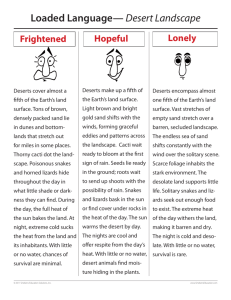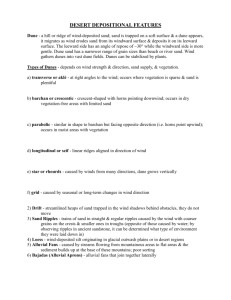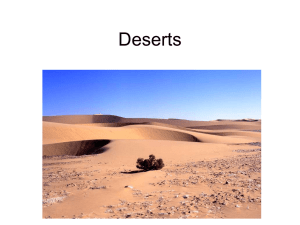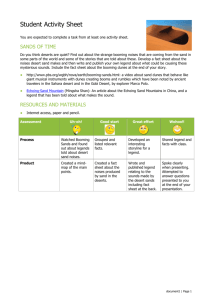The Oceans
advertisement
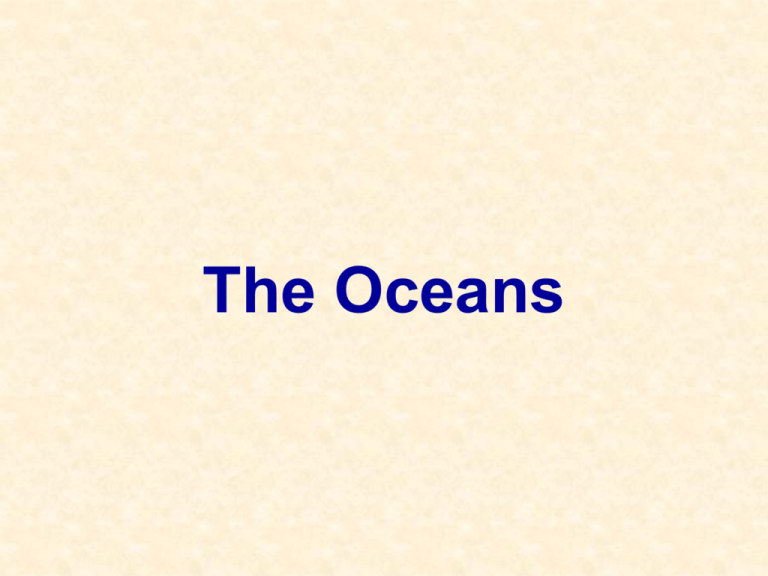
The Oceans Ocean-Atmosphere Links Exchange of water, carbon dioxide (gases) and heat. Surface currents are driven by atmospheric circulation. Surface Currents Surface Currents Transfer heat from one place to another. Keep the upper 100 meters of the ocean well mixed. The Ocean is Stratified Oceans and Climate Heat transferred from the Equator towards the poles. Example: England has a relatively warm climate at a latitude of Northern Canada. Thermohaline Circulation Thermohaline Circulation Driven by Density Differences, difference in temperature and salinity. Completes cycle in 6 yrs. Waves move energy, not water Important Parts Wave length Crest Trough Breakers Waves break when wave base = ½ wave length Rip Current (Rip Tide) Longshore Sediment Transport Barrier Islands Barrier Islands East Coast Sediments Current Wave Refraction Waves bend as they approach a headland Wave Refraction Creates Sea Arches and Sea Stacks Land's End is the westernmost part of England. The arch is near Cornwall about 10 miles from Penzance . Copyright ©2005 Bob Fagley This great double arch is in the Shetland Islands. The Islands, are the northernmost outposts of the United Kingdom and lie N.E. of northern Scotland. Copyright ©2005 Bob Fagley Tides Tides Tides Tides Deserts What is a desert? Less than 250 mm (10 inches) of precipitation. Generally lacking in vegetation. Cannot support a large population ?? Types of Deserts (5) Subtropical – • Centered around 30o N and S latitude • Controlled by air circulation • Geographically extensive Global Atmospheric Circulation Troposphere 30o Latitude Warm wet air rises. It cools and it rains Hadley Circulation Cell Ground or Ocean Equator Cold dry air falls. As it warms it begins evaporating moisture Subtropical Desert Examples: Sahara and Great Australian Types of Deserts Continental Interior• Far from sources of moisture (ocean) Continental Interior Desert Example: Gobi in Mongolia Types of Deserts Rainshadow• Mountain ranges cause barrier to flow of moisture. Rainshadow Desert Examples: Cascades and Sierra Nevada Types of Deserts Coastal Desert • Cool dry air blows in from the ocean and evaporates occurs as it warms. Coastal Desert Example: Coast of Chile and Peru Types of Deserts Polar – • Cold air holds very little moisture. • What little precipitation falls remains as ice for 1000's of years. Examples: Greenland and Antarctica Erosion by Wind Abrasion – airborne particles chip off small fragments of other rocks. Ventifacts Erosion by Wind Deflation – removal of small, loose particles. Can form desert pavement. Deposition by Wind Dune – hill or ridge of sand deposited by winds. Dune Types Dependent on: • Sand supply • Wind velocity • Variability of wind direction • Surface over which the dune moves Sand Dune Summery Limited amounts of sand Barchan - wind from one direction Star - wind direction varies Longitudinal - Wind converges from two directions Abundant sand Transverse - wind from one direction Parabolic – wind blows in land on shores Barchan - Sand is limited, steady wind from one direction Longitudinal (Linear) - Limited sand supply, strong converging winds Star - Sand scarce, wind shifts Transverse - Abundant sand, moderate wind Parabolic - Abundant sand, strong offshore wind Sand Dune Summery Limited amounts of sand Barchan - wind from one direction Star - wind direction varies Longitudinal - Wind converges from two directions Abundant sand Transverse - wind from one direction Parabolic – wind blows in land on shores
